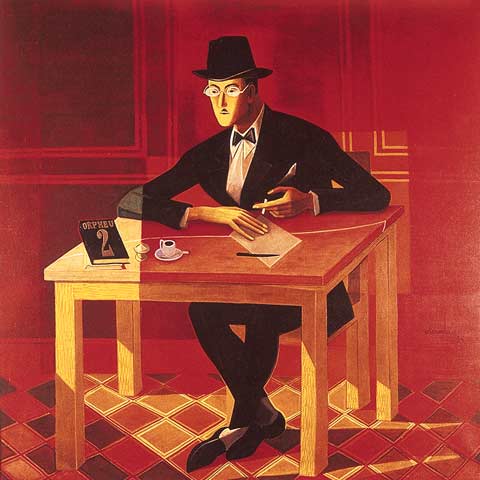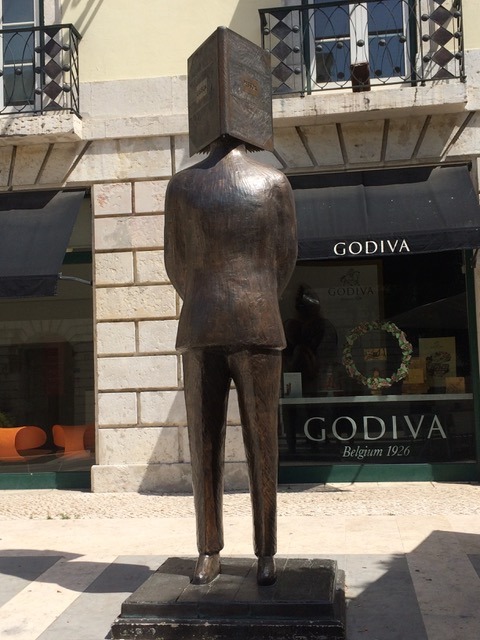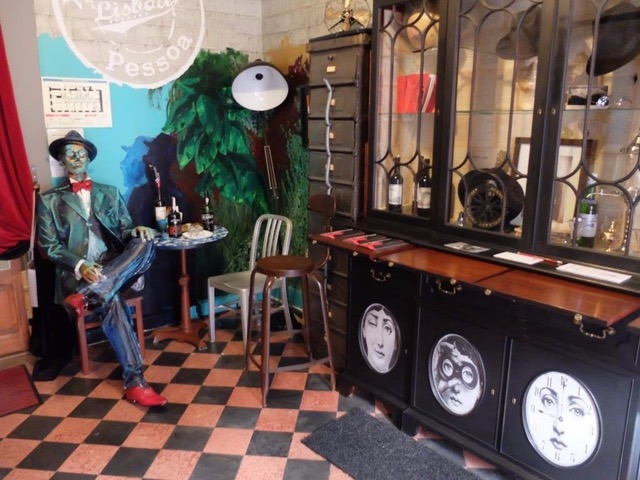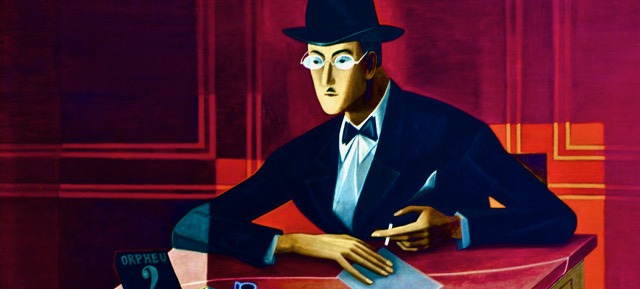Lisbon is now considered the capital of cool, but its most famous resident is a nerdy poet born there in 1888.
Fernando Pessoa was a surrealist before there were even Surrealists. Long before André Breton popularized automatic writing, Pessoa was practicing it, tapping into his subconscious.
Much of the work he penned, in fact, was attributed not to Fernando Pessoa, but to writers and poets he “channeled.” He dubbed them “heteronyms,” creating at least 72 of these alter egos over his short lifetime.
Mind you, these were not pseudonyms but full-blown personalities with histories and styles of their own. Many even had their own horoscopes.. .
In addition to being the greatest poet of the Portuguese language, Pessoa also was a publisher, a translator (growing up in South Africa, he spoke English fluently), a literary critic and a non-fiction writer. He only published one book in his lifetime though – a book of poems called Mensagem (Message).

After his death in 1935 at age 47, however – 30,000 typewritten pages of unpublished works were found stuffed in a trunk in his rented room. Among the discovered treasures were poetic masterpieces, a travel guide to Lisbon entitled What Tourists Should See and the famous project that most assured his fame, The Book of Disquiet. The trunk assured his fame.
The Book of Disquiet is attributed to one of Pessoa’s most prolific heteronyms, Bernard Soares, an ordinary office worker. Pessoa wrote the book’s preface.

Made up of hundreds of fragments, he called it a “faceless autobiography.” Included were such delicious ruminations as “My soul is a hidden orchestra; I know not what instruments, what fiddlestrings and harps, drums and tamboura I sound and clash inside myself. All I hear is the symphony.”
And “To write is to forget. Literature is the most agreeable way of ignoring life.”
The only problem was Pessoa left behind no instructions as to how to put the book together – no one is certain in what order the fragments were meant to be read, which only added to its, well, disquiet.
The spirit of Pessoa (whose name, appropriately means person or everyman in Portuguese) is everywhere in his native city. From the building where he was born in Largo de São Carlos to his tomb in the Monastery of Jerónimos, walking in Pessoa’s footsteps is the perfect way to tour Lisbon.
Pessoa was born in the Chaido neighborhood of the city on the fourth floor of a building that looks across the square to the iconic San Carlos Theater. In 2008, a statue by Jean-Michel Folon was placed in the square to commemorate the poet’s 120th birthday: It’s a figure whose head is a book. Appropriately, the statue faces a Godiva chocolate shop – chocolate was the subject of one of Pessoa’s most famous poems (“Believe me, there’s no metaphysics on earth like chocolates. . .”)

After spending his youth in South Africa where his stepfather served as the Portuguese consul in Durban, Pessoa returned to Lisbon at age 17 never to leave again. He went to live in a building owned by his uncle in the Largo do Carmo, not far from his birthplace. From his bedroom window he could see the ruins of the Carmo Convent.
Pessoa was a regular at the nearby Café A Brasileira, opened in 1905. On the terrace out front there’s a bronze statue of the poet, seated at a table with his legs crossed, next to a chair that is usually occupied by tourists posing for photos.
He also frequented the Cafe Martinho da Arcada, a restaurant in the Praça do Comércio which faces Lisbon’s harbor. There he would write, meet with friends or just stare out at a point in the room without moving or talking for hours. He was last seen at the restaurant on November 26, 1935, four days before he died. His table is still reserved for him.
Another Pessoa hangout was A Licorista, a bar on the Rua dos Sapateiros (Street of the Cobblers) where one of the few photographs of him was taken. That photograph is immortalized in a tile panel on display at the place, which is now a restaurant.
The rented room in Campo de Ourique, the Lisbon neighborhood where Pessoa spent his last 15 years, is now part of a museum, library and cultural space called the Casa Fernando Pessoa. You can see many of his personal possessions there, including that infamous trunk.
The Tram Number 28 that Pessoa used to commute between his rented room and his downtown haunts still runs the same route.

While in Lisbon I stayed at The Pessoa, an inexpensive guest house in that building where Pessoa lived when he returned to Lisbon for good. Who knows, maybe I even stayed in Pessoa’s actual bedroom. Like Pessoa, I had a great view of the ruins of the Carmo convent.

The rooms at The Pessoa — not to be confused with the more upscale and more expensive Lisboa Pessoa Hotel down the street — are named after the poet’s only girlfriend, Ofélio Quiroz (Pessoa never married) and his most famous heteronyms — classist and doctor Ricardo Reis, the uneducated Alberto Caeiro, Álvaro de Campos – an unemployed, bisexual naval engineer – and the enigmatic Fernando Pessoa.

In the hotel’s tiny lobby, there was yet another statue of the poet seated at a table. He looked like he was beckoning me to sit down beside him and have a drink, so that’s what I did.
How cool is that?
My Favorite Pessoa Poem
. . .
Eat your chocolates, little girl,
Eat your chocolates!
Believe me, there’s no metaphysics on earth like chocolates,
And all religions put together teach no more than the candy shop.
Eat, dirty little girl, eat!
If only I could eat chocolates with the same truth as you!
But I think and, removing the silver paper that’s tinfoil,
I throw it on the ground, as I’ve thrown out life.
From “The Tobacco Shop” by Fernando Pessoa (1888-1935)
. . .
– Margo Hammond
creativelatebloomers.blogspot.com






